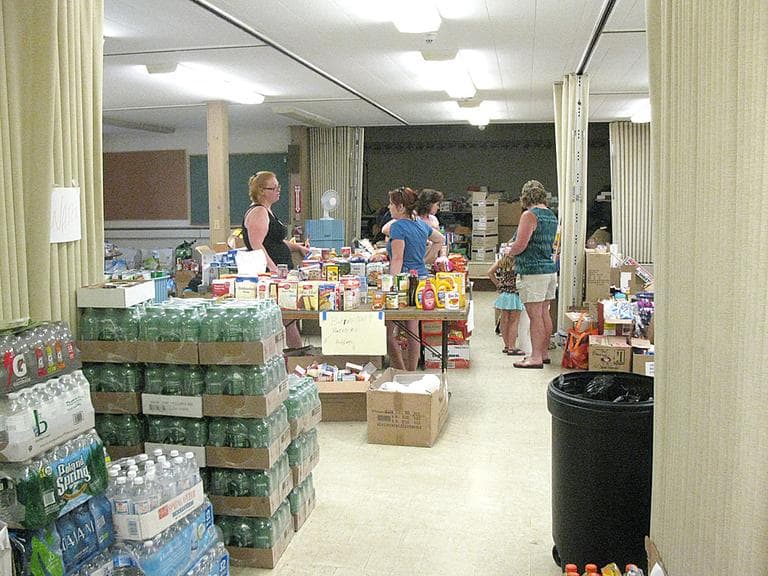Advertisement
Social Networking Sites Help Monson Rebuild After Tornado
ResumeParts of Monson have been obliterated by the F3 tornado that hit the town nearly two weeks ago, but recovery efforts are humming, in part because of what’s going on at The First Church of Monson. The landmark has lost its steeple for now, but volunteers there mobilized since the day after the tornado hit. Monson could provide some useful lessons for other places hit hard by natural disasters.

The Red Cross has moved to the First Congregational Church, with its clock lying twisted on the lumber-littered lawn. They’ve moved here from the town offices because they’ve recognized that this is where everyone in town is coming seeking help. Caitria and Morgan O’Neill are two of the reasons that the church has become rebuilding central. The two sisters are from Monson.
"We're the yellow house with the green shutters, and the yellow tag," said one sister.
A yellow tag means restricted occupancy. In the O’Neills’ case, they can live there, but can’t turn on their furnace until their chimneys are rebuilt. Caitria was in the front yard as the tornado touched down.
"My dad and my little brother pulled into the driveway right at that time, and then the lamppost next to them came out of the ground and flew across the yard. We all ran down to the basement pretty fast, and the house shook for a while, and then we opened up the back basement door that looks over the valley now, that used to be just trees, couldn’t see anything," she said.
Although the O’Neills are from Monson, they live in Cambridge now. Morgan is a doctoral student at MIT.
"I study hurricanes," Morgan said, laughing. "Appropriately."
And I just graduated from Harvard, I studied political science," Caitria said.
Morgan knew that a graduating senior at Monson High School, Laura Sauriol, had set up a Facebook page while the twister was bearing down on her house.
"It had 1,000 members, and people were rapidly posting needs and abilities. And we thought, 'This is an incredible tool, and we need to link this up to the center of the storm response,' and that happened to be the First Church, because we’re so visible here," Morgan said.
"Our operation is massive, and the best, fastest way you can possibly get things you need is tell the Internet, so we did that. With Facebook, we find that we just post what we need, and within half an hour, we’ve got it."
Morgan O'Neill, volunteer
"We lost our steeple. It’s the most recognizable part of Monson, and people come here to donate things, but the church had absolutely no link and no knowledge of this Facebook site."
Morgan thought that by linking to the Facebook page, they could link people asking for help with people offering help almost immediately.
"Our dad had an air card, and that’s just something that you can plug into a laptop and get Internet from a cell network, and we had someone make a First Church emergency account, and then just start posting on the page, and it’s turned out to be phenomenal," she said.
Morgan says the moment First Church needs anything: fruit for the workers, or burgers, someone fills the need.
"We’re sending out maybe 100 chainsaw workers daily," Morgan said, "And crews with water, and lunch and snacks," Caitria added.
"Our operation is massive, and the best, fastest way you can possibly get things you need is tell the Internet, so we did that," Morgan said. "With Facebook, we find that we just post what we need, and within half an hour, we’ve got it. It’s incredible. I think that social networking has transformed emergency response, at least for our little town."
And it's not just the Facebook page, says Caitria.
"We’re also creating a volunteer database with the person’s name, their phone number and then what their capability is, or what the large donation item they're willing to give is, and then we have an Excel database that we can look through," she said.
"When somebody comes in and says, 'I need a dump truck,' we have five people with dump trucks and we have their phone numbers and we can call them and have them on their way within a half hour. I think it’s a really useful format for emergency response."
Morgan says community organizations should incorporate social networking into their emergency response plans.
"Things need to be rewritten, because people want to give, and they can, using the Internet, and we need to tap that, because people picking through debris and rubble don’t sit at a computer asking for things, but we can," Morgan said. "So if they walk up to us and say, 'Hey, I need sunscreen. I got a bad burn,' you can get that instantly."
"And also knowing what the community needs. In the first couple of days, very few people came to us asking for specific help, because they didn’t know that we could send it to them," Caitria said.
So, Caitria said, the church started sending out volunteers.
"People who knew the town, who knew the people here, to go from house to house to see what each family needed, who lived in the house, if they were yellow tagged, things like that, just to collect information," Caitria said. "And then once the families talked to these people who were canvassing, they were able to say: 'Oh, you can get a generator at the First Church? You have an extra refrigerator? You can take this tree down?' People weren’t aware of the help that was available."
Their work in Monson has been transforming for the O’Neills, especially for Caitria, who just graduated from Harvard.
The O’Neills say this is a really cool thing that’s going on in Monson. And they say if they can do this with two laptops and a slow Internet connection, it can be done anywhere. Monson is doing so well that they’re helping other towns that were hit.
More:
This program aired on June 13, 2011.
